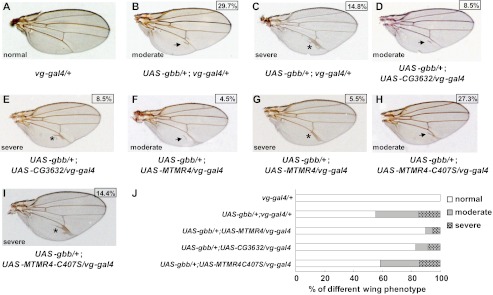FIGURE 5.
MTMR4 and CG3632 ameliorate vein defectiveness induced by forced Gbb signaling. A, representative genetic control wing (vg-gal4/+) with normal morphology. B and C, overexpression of Gbb caused deformity of vein development. Representative wings of UAS-gbb/+; vg-gal4/+ flies (n = 155) showed moderate (B) and severe (C) vein defects. D and E, co-expression of CG3632 antagonized Gbb. Representative moderate (D) and severe (E) defective wings of UAS-gbb/+; UAS-CG3632/vg-gal4 (n = 106) flies were shown. F and G, co-expression of MTMR4 antagonized Gbb. Representative moderate (F) and severe (G) defective wings of UAS-gbb/+; UAS-MTMR4/vg-gal4 (n = 110) flies are shown. H and I, loss of DUSP activity of MTMR4 failed to antagonize Gbb. Representative wings of UAS-gbb/+; UAS-MTMR4-C407S/vg-gal4 flies (n = 139) are shown for moderate (H) and severe (I) vein deformity. In the aforementioned figures, the black arrow indicates ectopic vein branches near PCV and L5, and the asterisk indicated ectopic vein tissue. Corresponding moderate or severe percentage scores derived from Fig. 4J are shown in boxes. J, statistics of various phenotypes of vein development of all flies in A–I is plotted in the bar graph.

